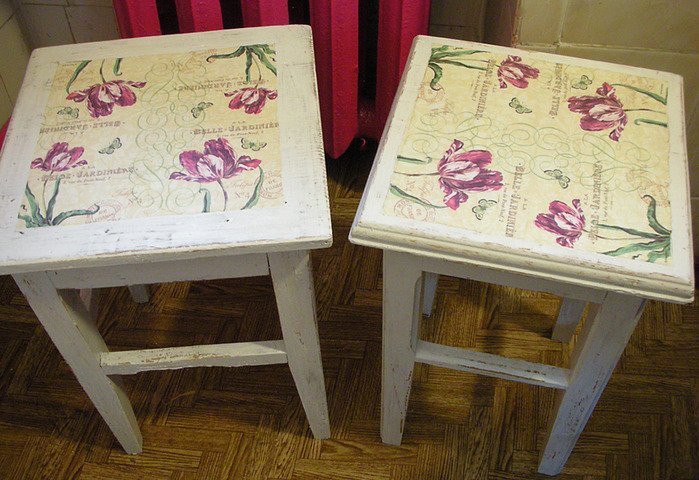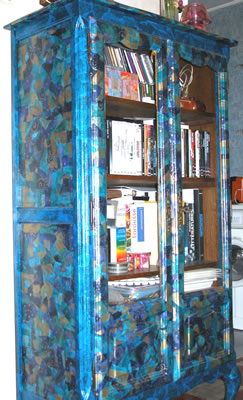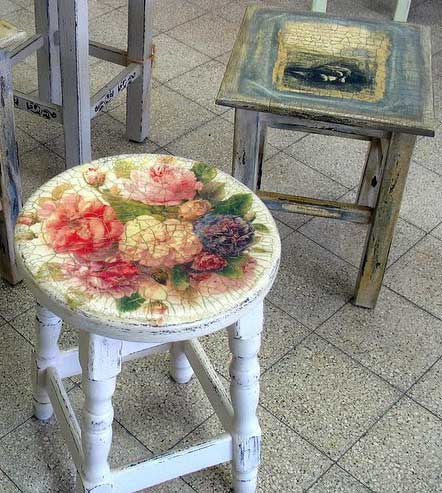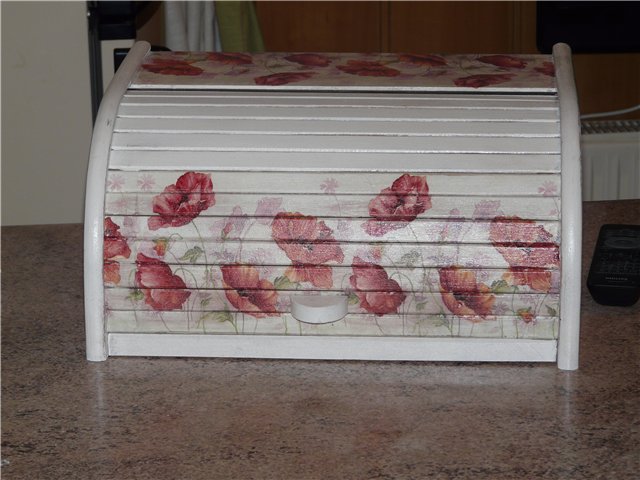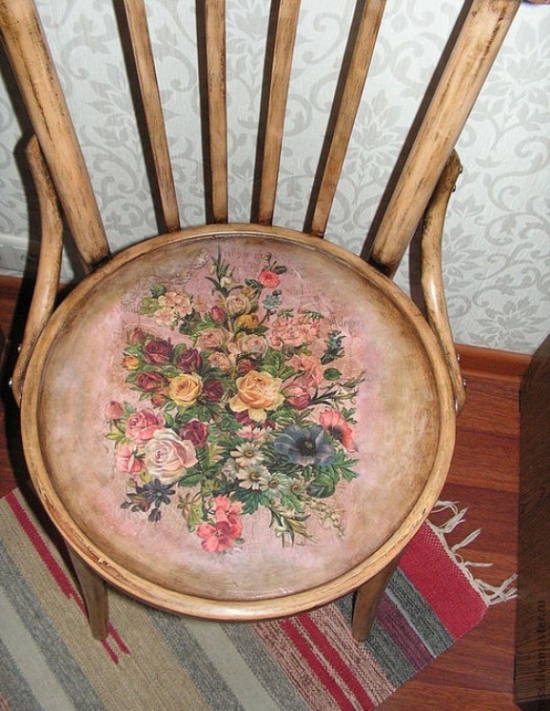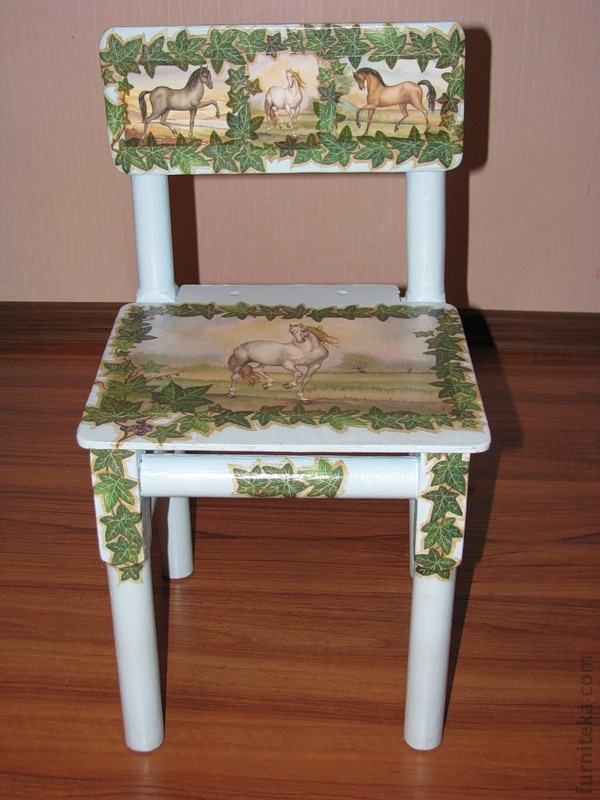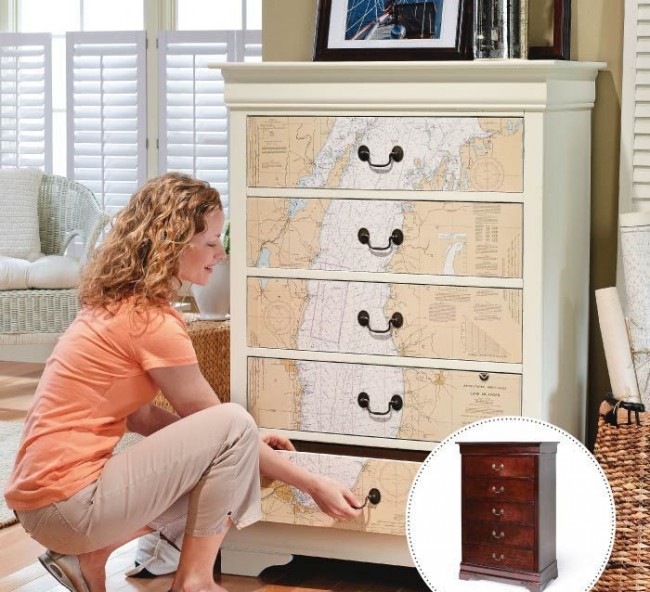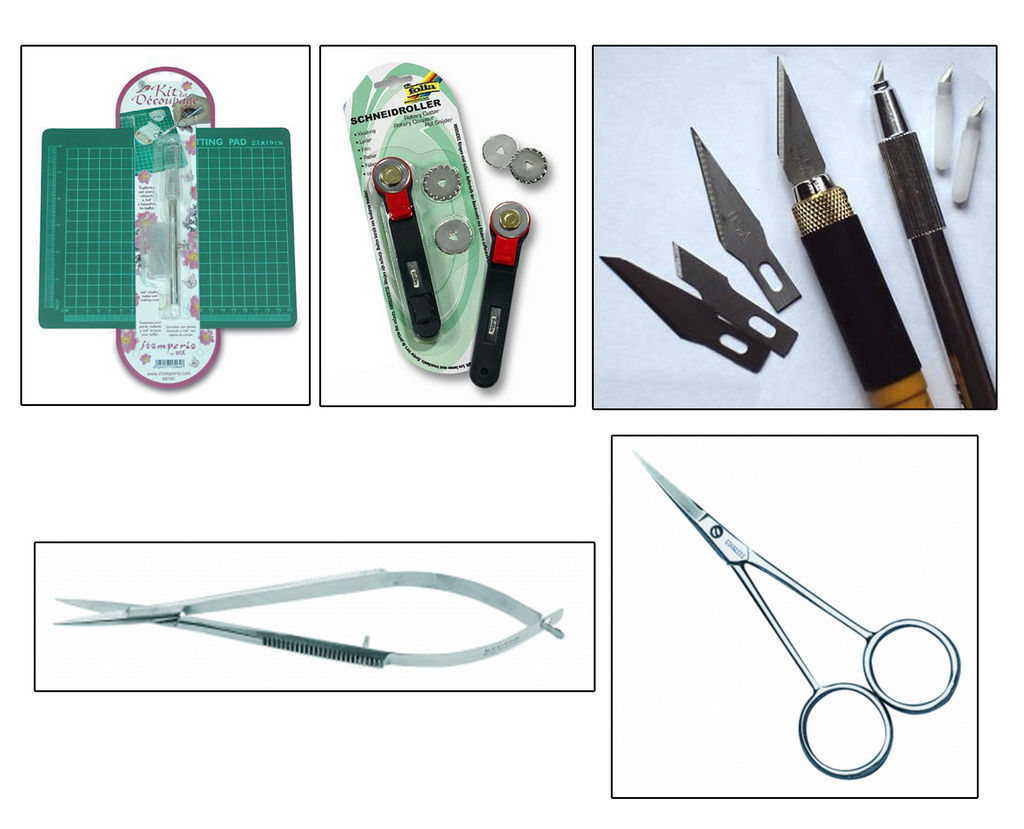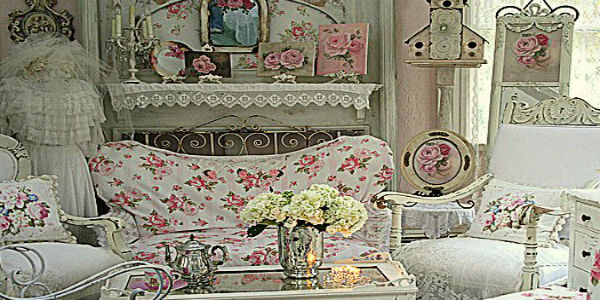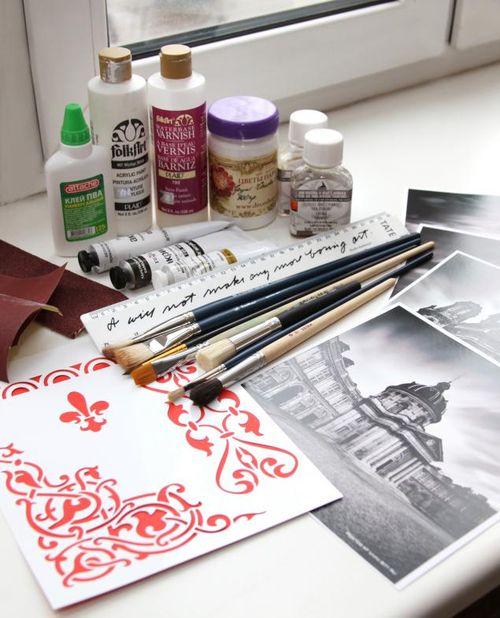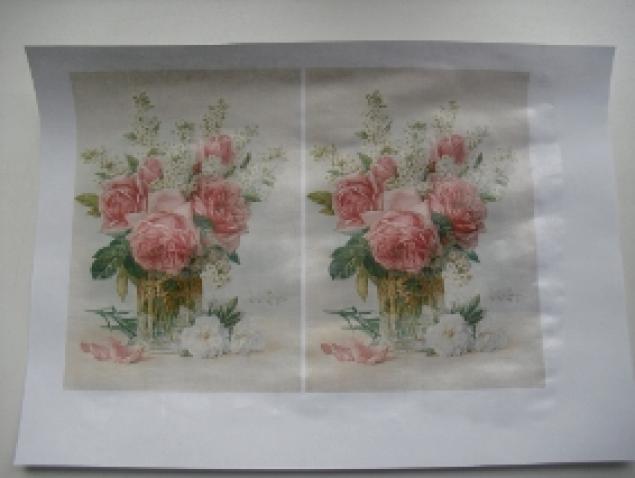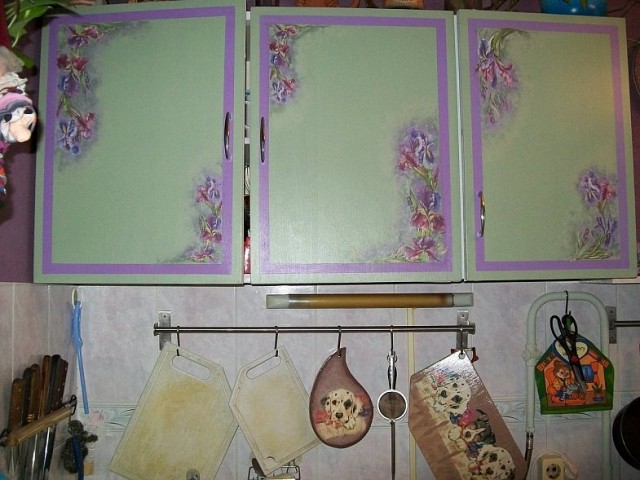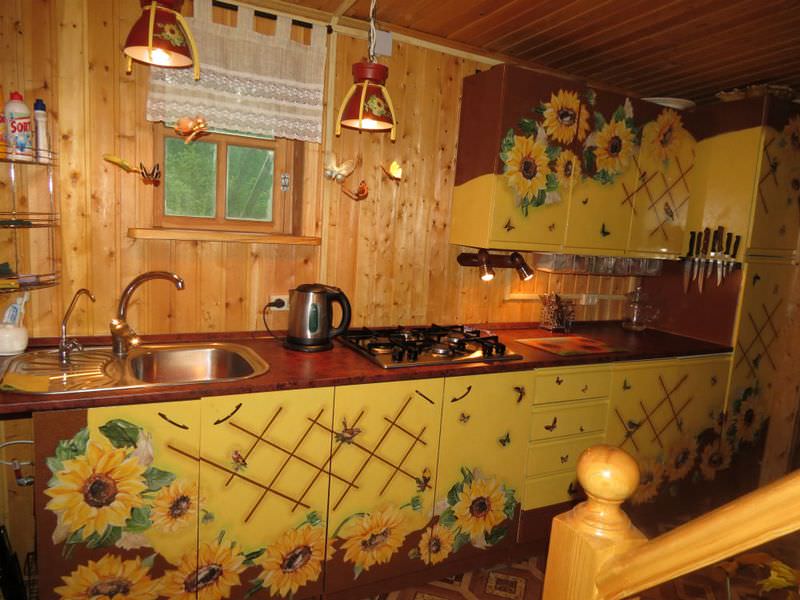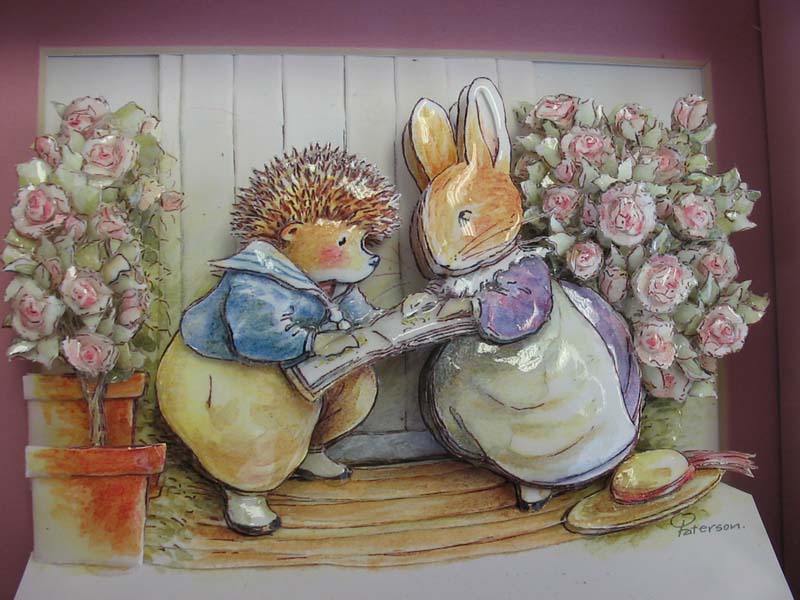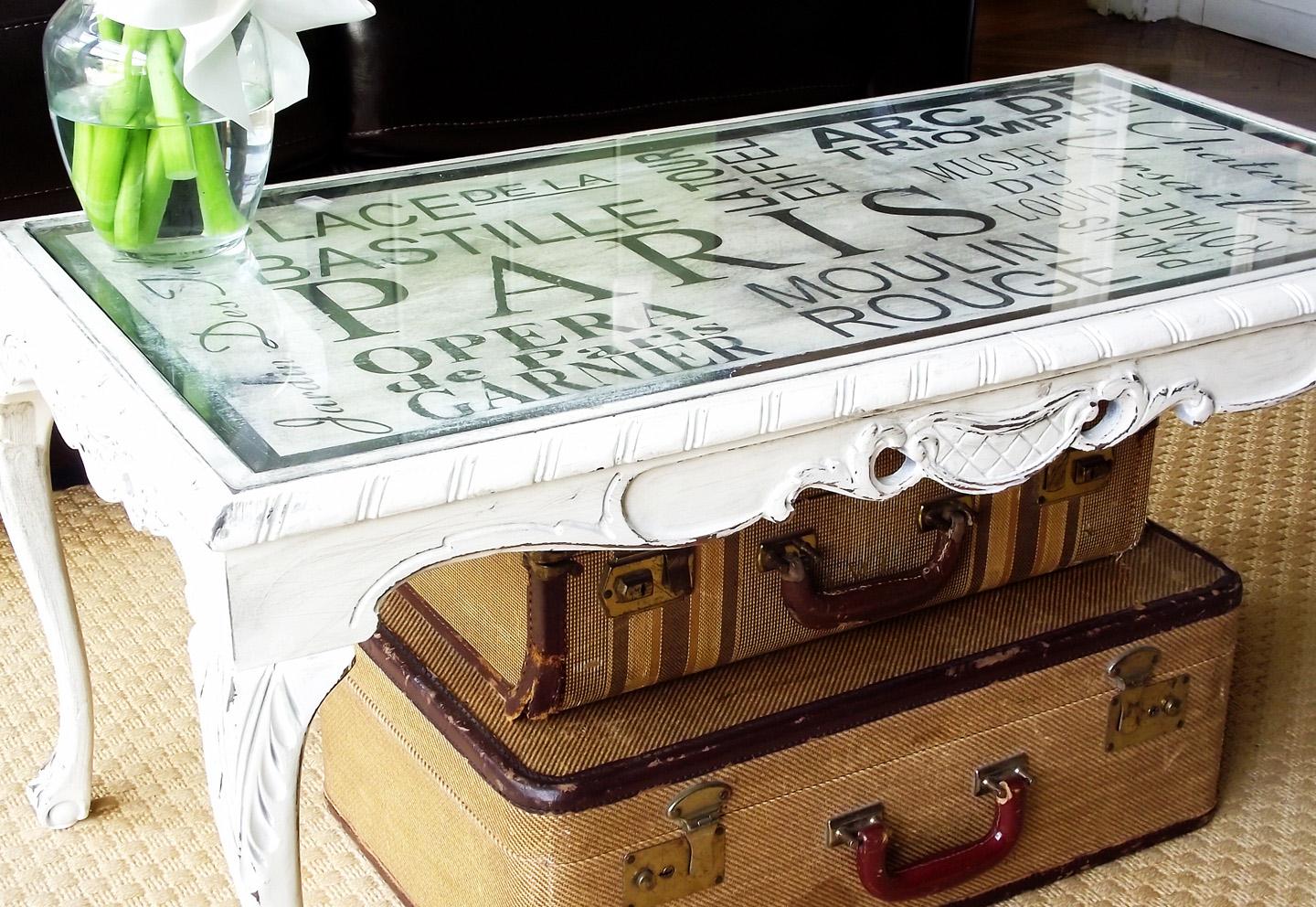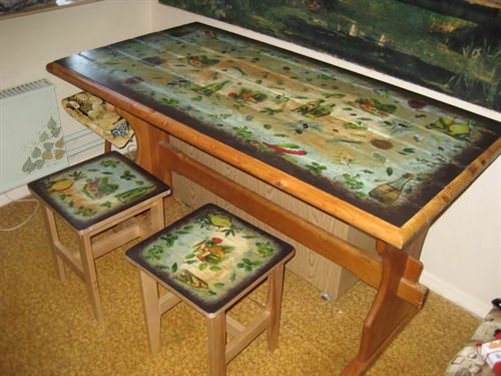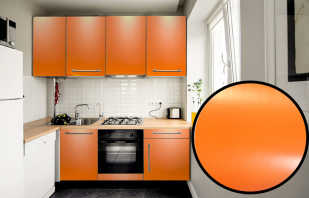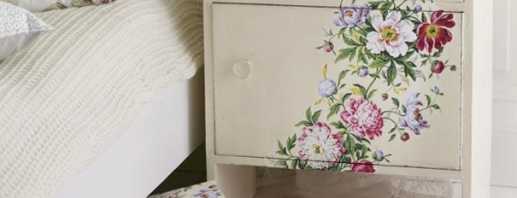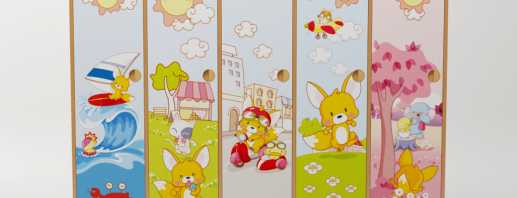Tips for making do-it-yourself decoupage from napkins on furniture
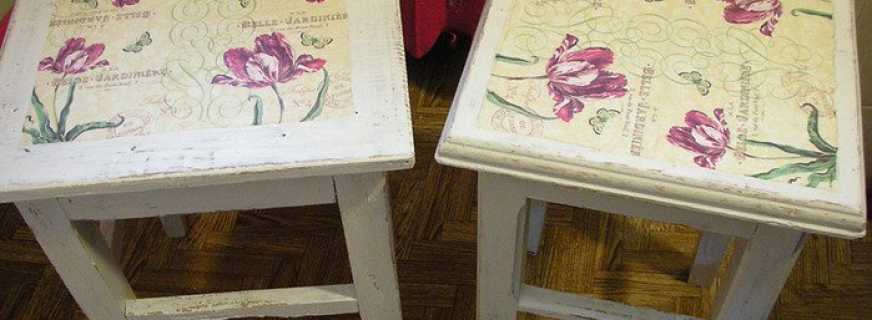
Decoupage is a simple and inexpensive way to update furniture. An old cabinet, bureau or sideboard, decorated in a similar technique, becomes a real work of art, turning from a typical model into a real design masterpiece. For restoration, you can use various materials - fabric, newspaper and magazine clippings, special paper. We offer you to find out an interesting and simple decoupage of furniture with do-it-yourself napkins, which is quite simple to implement.
Content
Features of the technique
The principle of decoupage technique is in the name itself. From French, the word "decoupage" translates precisely as "clippings." This is the main principle of work - cut out various images and glue them on the surface. You can decouple a variety of items. From large elements of furniture - the facades of cabinets, countertops, doors, to the smallest little things - vases, candles, original jewelry or caskets. When decoupage, it all depends on your imagination and patience.
The history of decoupage dates back to the 12th century in China. The heyday of decorating with this style came in the 17th century, when European aristocrats began to fill their homes with expensive Asian household items, and the Venetian craftsmen, sensing good earnings, learned to give exotic notes to the products of local furniture makers.
Nowadays, faceless industrialization and patterns, any hand made products are in great demand and interest among creative people. Therefore, decoupage is again at the peak of popularity.
The most common today are six main types of decoupage technology:
- classic (direct) decoupage - the basic method in which the picture is glued or implanted on the prepared surface. If you want to decorate a product made of wood, MDF or particleboard - the surface must first be sanded and primed. This method is good for beginner needlewomen, as it will help to understand the basic techniques of decoupage;
- reverse decoupage - used for decorating transparent surfaces - dishes, glass, mirrors. It differs from the direct sequence of actions - first, the base is laid on the back side (napkin, clipping or any other picture), and then the surface is primed and varnished;
- artistic (smoky) decoupage is a shading and drawing of the background, which allows you to effectively emphasize all the outlines and nuances of the picture. Using smoky decoupage, you can create a complete picture with shadows, volumes and accents, as well as hide small flaws in the work. Colored haze is created using pastel or acrylic paints, after which the surface is coated with matte varnish;
- Dekapatch - a patchwork from paper.With this option, decoupage uses pictures previously torn into arbitrary pieces. This style of decoupage is also great for beginners, as it does not require special skills, based only on the author's artistic intentions. Flaps can be glued overlap or almost butt, leaving a thin border. Thus, the subject can be given a touch of artificial antiquity or create the effect of natural stone. Do not forget to cover the finished work with a protective layer of acrylic varnish;
- volumetric - a modern version of the technique in which pictures are created with a fashionable 3D - effect. This is a technique for experienced craftsmen, it is better for beginners to start with simpler work. For volumetric paintings you will need modeling paste, special art gels, putty, base. The basis is pieces of fabric, multi-layer napkins, and you can use decoupage cards or special Sospeso Trasparente equipment.
Work in 3D decoupage technique requires a lot of experience and accuracy, but the result is very effective and unusual.
The choice of motives
There are a lot of motives for decoupage, all of them are limited by the personal preferences of the author and the degree of integration of the decorated object into the surrounding interior. You can cut a beautiful pattern from paper napkins, decorate a selected surface with old photographs, use pictures from magazines or print out a print with your favorite laser printer. Furniture modules of standard models, decorated using decoupage technique, immediately attract everyone's attention, bring zest and exclusivity to the interior of your home.
Since decoupage is most often used to restore worn, problem areas on furniture, bright and ultra-modern designs are rarely used as the basis for decor.
The most common subjects used for decoupage furniture are:
- floral motifs;
- pastoral drawings;
- country style;
- fruits, berries, vines;
- angels, religious subjects;
- birds
- Japanese, Asian motifs;
- old postcards or photographs.
It is such stories that most organically fit into the interior of the beloved by many style of Provence, ethno or always relevant classics.
Tools and materials
Decoupage technique opens up a wide choice for self-expression and does not require significant material investments. But still, for the correct and beautiful result, it is necessary to arm yourself with some tools and materials.
What tools will be required for this:
- sharp little scissors. Conventional manicure, medical or special scissors for tapestries are suitable. The main condition is a short sharp blade. The best option would be to use Teflon-coated scissors. Such scissors are not subject to corrosion, glue and paint do not stick to them;
- a decoupage knife with a rotating blade or a scalpel - used to process dense materials;
- several types of brushes - for shading, applying glue and a protective layer (varnish). These should be synthetic products of different thicknesses. It is also convenient to use a soft foam sponge for these purposes;
- primer - for surface preparation. You can use PVA glue or putty with acrylic;
- glue - special decoupage (for dense applications), PVA, wallpaper, paste, acrylic varnish, egg white;
- paints for the background - acrylic, pastel, pigments;
- roller - to smooth the glued picture.
Of the materials for decoupage, you will definitely need:
- Wipes are an affordable material recommended for beginners. You can buy special products in the departments for needlework, or you can just buy the usual sets of three-layer napkins with a beautiful pattern. A pack is very inexpensive, so making a mistake, you can easily start over using another paper picture.The disadvantage of this material can be called its fragility and the ability to stretch and form wrinkles during operation. It is advisable to apply a napkin to a light surface, the dark base will simply “eat” the drawing on thin material;
- decoupage cards - are sold in specialized stores and are of various sizes of drawings, collected in sets on a specific topic. Since these products are designed specifically for decoupage, their material meets all the requirements of technology - they are elastic, tear with difficulty and do not change their size and shape when in contact with water. Decoupage cards are especially convenient for restoration of very dark surfaces;
- rice, banana or mulberry paper is a fibrous material used to decorate transparent surfaces. It is not cut with scissors, the drawing must be carefully cut off with your hands. Due to its texture, such paper does not tear, perfectly repeats all the outlines of the subject, so it is easy to work with it and get an effective result;
- prints - an option for those who want to make an exclusive decoration by printing their favorite pattern on a conventional laser printer. Use the cheapest thin paper or tracing paper - it absorbs paint better and, when decoupled, will not stand out much on the surface of the item. In order for the printed pattern not to blur when working, sprinkle it with ordinary hair spray.
Decoupage by the example of a locker
Many houses have old furniture, which still regularly performs its functions, but has already lost its visual appeal. Or maybe you just don’t want to part with your favorite thing, but you want to give it an individual and unusual look? Try your hand at decoupage technique. And we will show you how to make a decoupage of furniture in stages with a do-it-yourself napkin using the example of a standard kitchen cabinet.
Step-by-step instruction on the stages of work:
- remove the door and prepare the surface - polish it with a grinder or sandpaper. Using a putty or soft wax, fill in any cracks and scratches on the furniture. Leave to dry completely;
- prepare the base - pick up a paper napkin with the picture you like and carefully remove the top layer from it - we will apply it on the facade of the cabinet door;
- apply a thin layer of glue to the inside of the wipe. You need to act very carefully, apply glue with a thin flat brush, avoiding the ingress of excessive quantities. Leave the napkin for a while so that the glue completely saturates the material. For gluing paper products, you can use ordinary stationery PVA. In order to conveniently transfer the picture and not ruin it, work on a plastic file;
- transfer the napkin to the front of the cabinet, arrange to your liking and smooth the material with a brush. Move from the center to the edges to remove excess air and smooth wrinkles;
- The main work is completed. Now the last step remains - to varnish the surface. This should be done no earlier than a few hours, it is better to leave the product overnight. For the protective layer, matte or glossy acrylic varnish is suitable. Apply varnish at least 4 times. This process is best carried out using an aerosol dispenser.
In such a simple way of decoupage, at no particular cost, you can make an original exclusive thing for your home. Look at examples from the photo, how old furniture was transformed, after its restoration with the help of decoupage.
The nuances of technology
Modern needlewomen are not limited to simply pasting beautiful pictures. To date, several decorating techniques have developed with the help of decoupage, helping to give the furniture an original unusual look:
- gilding - the decorated surface is covered with a layer of potal, which is an inexpensive analogue of gold leaf.This method allows you to enhance the effect of luxury and royal chic, perfect for interiors in the Baroque style, art deco, empire;
- patination - the creation of patina, artificial aging of an object. Such a decoupage technique is actively used in a rustic or classic interior. The general background of the surface to be decoupled depends on what type of patina is applied - silver, bronze or noble shade of natural wood;
- tinting - creating a background and shading using acrylic paints. It is used to give contrast and enhance the color of the picture;
- Craquelure is another kind of add surface to the visual effect of antiquity. This is a very unusual decoupage technique, in which cracks are formed on the subject, emphasizing the originality of the material. Two types of craquelure are distinguished - one-component (cracks in the paint layer) and two-component (cracks in the top layer of varnish are added). A rather complicated process, it looks especially beautiful on transparent surfaces - saucers, vases, decorated with cute pastoral or floral plots.
Decoupage is a great way not only to give a “new life” to old things, but also a wonderful process of self-expression. Many designers admit that this hobby is so exciting, it allows you to forget about problems, and the result is so pleasing that decoupage has become their main activity. Try it, too, as decoupage becomes much easier with our tips.
Video

